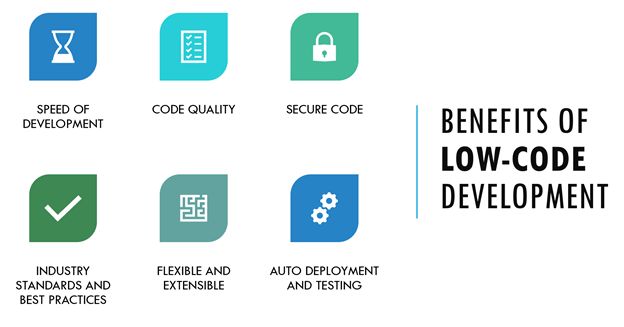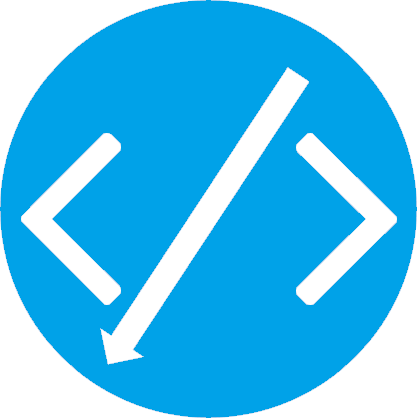Free Facts On Deciding On Low-Code Platform Info
Wiki Article
Benefits Of Developing Applications Using Low-Code In Terms Of Speed
The development of applications using low-code significantly improves the speed of development due to a variety of important factors. Development Environment:
Drag-and-Drop Interfaces: Low-code platforms provide visual tools for designing applications. Drag-and-drop elements are a great tool for developers to quickly assemble apps without extensive code.
Templates and components that are pre-built A lot of low-code platforms come with pre-built components as well as templates that allow developers to rapidly prototype and develop applications.
Coding needs that are reduced:
Automated Coding Generation: Low code platforms automatically generate code in accordance with the visual model designed by the developers. This eliminates the need to write code manually and speeds up the process of developing.
Reusable Components: Developers are able to make use of reusable components across various projects, which reduces the amount of time they spend creating and testing code.
A more efficient collaboration
Low-code platforms have a myriad of tools to facilitate seamless collaboration between teams working on development. They include version control, testing and deployment.
Citizen Development: Non-developers and business users can benefit from intuitive interfaces to contribute to the development of applications which can reduce bottlenecks caused by a lack of available professionals to develop applications.
Rapid prototyping, rapid iteration, and rapid prototyping
Rapid Prototyping: Developers design prototypes quickly to validate ideas and collect feedback. This can result in a shorter iteration cycle.
Easy Modifications – The visual nature of low-code development permits easy updates and changes that speed the process of refining applications based upon user feedback.
Pre-built Integrations:
API Integrations: Platforms that are low-code usually come with pre-built connectors for popular services and APIs which reduce the time needed to integrate external systems.
Data Integration: Built in tools for data-integration make it easier to connect databases and data sources. This accelerates development.
Scaling, deployment and deployment
One-Click-Deployment: A lot of Low-Code platforms offer one click option for deployment. This can reduce the time and efforts required to set up an application.
Cloud-based solutions: Cloud-based low-code platforms can handle scaling and infrastructure management and allow developers to focus on the logic of their applications and functions rather than the logistics of deployment.
Overall, low-code development has the advantage in terms speed because of its capability of automating and simplifying many elements of development. This allows faster app delivery and a simpler adapting to the changing demands. Check out the most popular Low-code Platform for application development advice for website advice including develop mobile application, rad application development, rapid action development, develop cross platform mobile app, cross platform app dev, develop web application, build a docker container, rapid applications, build a docker container, application modernisation and more.

Advantages Of Low-Code Application Development In Terms Of Scalability And Flexibility
Low-code software has many advantages in terms of scalability. They are flexible and can be adapted to new requirements. Here are a few major advantages: Rapid scaling:
Cloud-based deployment: A lot of lowcode platforms are based on cloud computing, which allows applications to scale with the underlying infrastructure. This allows companies to handle an increase in load without worrying about managing servers.
Auto-Scaling Feature: Built-in features that automatically increase resources to accommodate demand and ensure constant performance without manual input during peak times.
Flexible Architecture:
Modular Application Design: A low-code platform allows for modular design of application. Components can be independently developed, tested and increased in size. Modularity improves flexibility and allows to expand or update specific elements of a program without affecting the whole system.
Integration of microservices: The ability to support microservices architecture enables applications to be developed as a collection loosely coupled services. This enhances both scalability, and flexibility.
Customizable Solutions:
Extensibility: Low-code systems typically allow custom coding and scripting, allowing developers to enhance the capabilities of the application beyond what is available out-of-the-box. This guarantees that specific business needs can be fulfilled without any limitations.
Third-Party Integrations: Businesses may incorporate additional functions and services into their apps by integrating with APIs and third-party providers.
Agile Development and Deployment
Continuous Delivery and Deployment: Low-code platforms are able to support agile methodologies that allow continuous integration and continuous delivery (CI/CD). This enables rapid deployment of new features and updates. The applications can change quickly in response to market changes and feedback from users.
Iterative Development: Thanks to the nature of iterative development low-code programs can scale and improve incrementally. This reduces the risks associated with major changes and allows for more controlled expansion.
Resource Optimization:
Effective Resource management: Platform tools that use low-code assist in optimizing the use of resources by monitoring and managing performance of software. This helps ensure that resources are used efficiently and can be scalable either up or down depending on actual demands.
Load Balancing : The integrated load balancing feature distributes workloads equally across servers. This increases the application's ability to handle large volumes of traffic, and ensures constant performance.
Global Reach:
Multi-Region Deployment: Low code platforms typically support deployment across several geographical regions, which allows companies to offer low-latency connectivity to users worldwide. This is of particular importance when it comes to applications that have a worldwide user base.
Localization Support for Localization included, which allows applications to be adjusted for various languages or regional needs. This enhances flexibility for various markets.
Maintenance and updates
Low-code software is visually appealing and modularly designed, which simplifies maintenance. Updates and bug fixes are done quickly and without a lot of downtime.
Version Control: Integrated version control system helps keep track of changes and rollbacks. This ensures that updates are easily deployed and previous versions can be restored if needed.
Cost Efficiency:
Reduced development costs: Low-code platforms permit a reduction in the development cost by eliminating the requirement to code extensively. This lets applications be scaled without an increase of the development cost or effort.
Pay-as-you-go models Many low-code platforms provide flexible pricing, such as the pay-asyou-go model, which aligns costs to actual usage and growth. This provides the flexibility to budget.
The flexibility of low-code apps lets businesses develop strong flexible, scalable, adaptable and durable applications. These platforms offer quick and efficient responses to changing needs, resource efficiency and constant improvements, which allows for applications to grow as a company. See the best product advice for more advice including application modernisation, develop web app, application modernization, rad application development, app development platform, rapid app development, lowcode no code, azure sql, azure sql, ms azure sql and more.

Low-Code App Development Has Many Advantages In The Area Of Collaboration And Workflow
Low-code development of applications offers a variety of benefits in workflow and collaboration, making it the perfect choice for businesses seeking to improve team efficiency and streamline development processes. Here are the top advantages: Improved Collaboration Across Functions:
Unified Development Environment: Low-code platforms provide a single, unified environment in which all team members comprising business analysts, developers, designers, and others, can collaborate effectively. This helps eliminate silos.
Visual Development Tools: Low-code platforms are easy to use, and come with a drag-and drop interface. This allows non-technical members of the team to participate in the development phase and ensures that business requirements are captured precisely.
Communication Enhanced:
Real-Time Collaboration: A lot of low-code platforms offer real-time collaboration options including the simultaneous editing of comments and instant feedback. These features enable continuous communication and cut down on the time wasted in back-andforth discussions.
Shared Workspaces : Teams are able to collaborate within collaborative workspaces. They can access and edit the elements of the project. This ensures that everyone works towards an agreed-upon goal.
Streamlined Workflow management:
Built-in Project Management Tools : Low-code platforms usually contain integrated project management software that aids teams organize, track, and manage, and coordinate their projects for development. This includes task assignment, progress monitoring, and management of deadlines.
Workflow Automation Automating routine tasks or workflows permits teams to concentrate their efforts on more strategic projects and activities which improve the overall efficiency of the company.
Faster Iteration cycles
Rapid Prototyping : Low-code systems allow rapid prototyping. They also permit rapid and iterative development. This allows teams to develop apps, test them and refine them in shorter periods of time. This allows for feedback to be quickly incorporated into the application, and for rapid improvement.
Agile Development Support The support for agile methodology lets teams be working in sprints, constantly delivering small increments of functionality and making it easier to adapt to changing requirements.
Accessibility for non-developers
Citizen development: Low-code platforms permit business users to modify and create applications with no programming expertise. This frees IT and development teams of the burden and allows quicker responses to business requirements.
Training and onboarding: Simple user interfaces and extensive resources for training help bring new members of the team up to speed. This enhances overall team's collaboration.
Centralized documentation and sharing of knowledge
Integrated Documentation: Low-code systems usually include features for creating and maintaining documentation within the platform itself making sure that all information about projects is easily accessible and centrally located.
Knowledge Repositories Teams can create and maintain repositories of knowledge that contain best practices templates, templates, and other reuseable elements, which facilitate the sharing of information and reducing duplication.
Consistency in Standardization
Standardized Components. Utilizing pre-built standard components provides consistency throughout all software. This helps team members learn and collaborate with various aspects of their projects.
Governance and Compliance - The built-in governance frameworks ensure that the development of every application follows organizational standards as well as regulatory standards. This helps to reduce non-compliance risk and assures that the application is compliant with high-quality standards.
Feedback and Improvement Loops
Integrated Feedback Systems: Low-code platforms offer integrated feedback systems that enable users to offer feedback on the applications. Feedback can later be utilized in the creation of these applications.
Continuous Improvement - The capability to quickly iterate deployment, change and deploy applications in response to user feedback helps them align with the business objectives and user demands.
Visualization, Reporting and Analyzing:
Real-time analytics: Built-in analytical and reporting features provide real-time insights about project progress, performances and user interaction. They facilitate the use of data to make informed decisions.
Visual Workflow Mapping Visual tools for mapping processes and workflows help teams comprehend and optimize their workflows by identifying the areas of improvement and bottlenecks.
When it comes to collaboration, low-code applications are an excellent way to simplify workflows, bring diverse teams together, and automate tasks. This results in a more cooperative, efficient, and agile development environment that ultimately leads to more effective applications and better alignment with business objectives.
